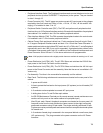
Specifications
Release 3.3 79
• Fiber optic cables are often more easily installed and pulled than copper because of their
light weight and flexibility. However, take care not to exceed the minimum bend radius or
maximum tensile strength.
• Procedures for the repairing, splicing, or assembling fiber optic cables are available from
fiber component manufacturers (many offer training courses).
WARNING: Fiber optic sources emit infrared light that is invisible to the human eye.
Never look directly into a source or into the end of a fiber energized by a source because
it can damage the retina.
When working with raw fiber optic cable, be careful of the fiber ends or slivers that can
puncture the skin or cause irritation.
Specifications
At each end of a fiber optic cable is a Fiber Interface Module (FIM). At the transmitting end, the
FIM converts electrical signals into pulses of light to be transmitted over the cable. At the
receiving end, the FIM converts the pulses of light back into electrical signals usable by the node.
The FIM connects the 3300 Controller to a peripheral unit or DSU. These FIMs cannot be
installed in the Applications Gateway. Each FIM variant may be identified by its optical
wavelength and fiber type (indicated on the FIM faceplate). The same FIM variant must be
used at each end of a fiber optic cable. However, a node may be equipped with different FIM
variants to suit the length of each cable run.
Fiber Interface Module Specifications (9400-300-301-NA)
Approximate maximum fiber cable run length (See Note 1) 1km (0.62 miles)
Power consumption (Watts) 2.5
Number of fiber links per FIM 1 Tx, 1 Rx
Fiber connector type ST (See Note 2)
Electrical interface
(See Note 3)
8 serial ST links
Optical wavelength (nm) 820
Optical budget (See Note 4) 6 db
Date rate (Mbits/second) 16.384
Bit rate after encoding (Mbaud) 20.48
Fiber optic cable type 62.5/125 um
Multimode
Notes:
1. The run length is the one-way length of fiber optic cable between nodes.
2. ST is a registered trademark of AT&T.
3. Some channels of the electrical interface are not available.
4. The optical budget is the allowable loss through fiber optic cable, splices, and connectors. The
optical budget applies to the run length.


















